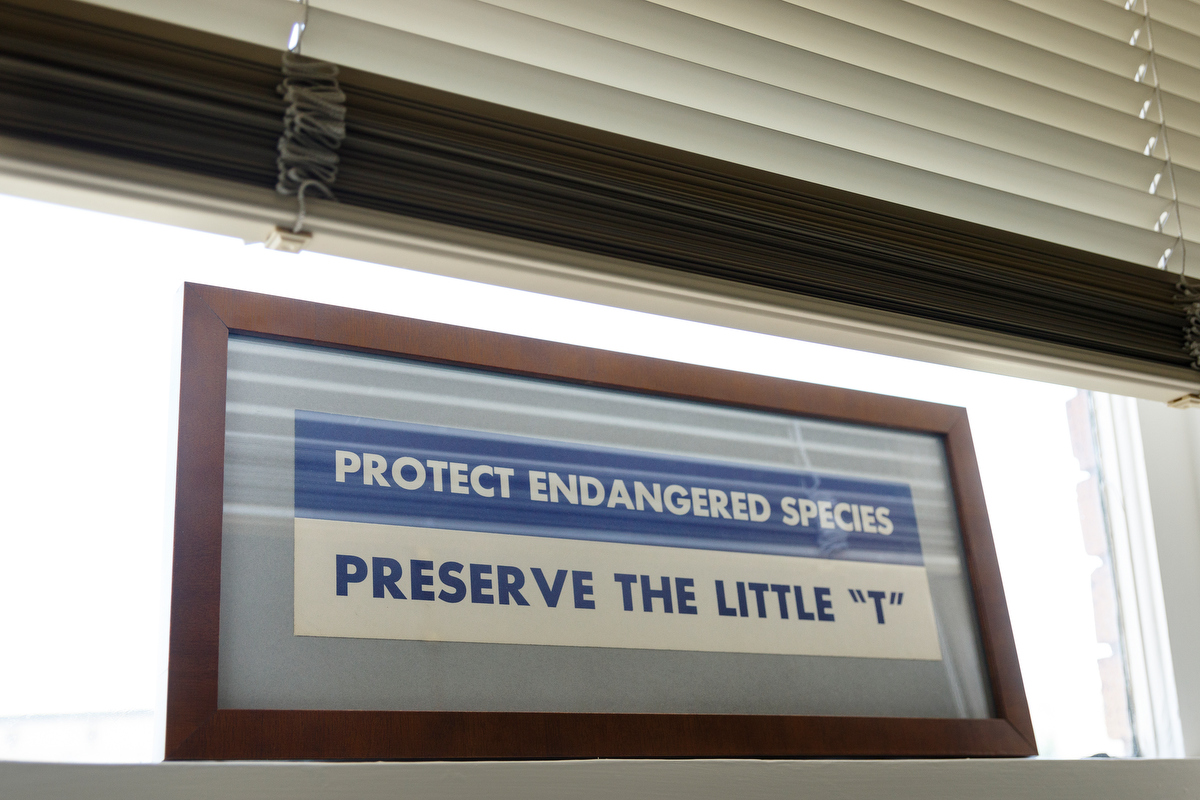A drawing of a snail darter sits in the window sill behind Hank Hill's desk in the office of the Georgia Avenue law firm bearing his name.
The photo of the three-inch-long member of the perch family serves as a reminder of yesteryear. It's from Hill's first case - one that took place before he was an attorney - when the lifelong Chattanooga area resident spent years fighting TVA starting as a second-year law student at the University of Tennessee at Knoxville.
The 1978 case, Tennessee Valley Authority v. Hill, was one of the most famous conservation fights in Tennessee history and ultimately reached the U.S. Supreme Court, which ruled in Hill's favor. The ruling halted construction of a decades-long project to build a dam on the Tellico River. The court sided with biologists who argued the dam would kill the remaining snail darter population, violating the newly formed Endangered Species Act of 1973 (Hill and a group of biologists helped get the species federally listed. It was one of the first species protected under the Endangered Species Act and one of the first court cases invoking the act's protections).
Now, the fish he fought so hard to save may lose federal protection, but conservationists argue the change is good, signaling the blossoming health of the fish's population.
Protecting the Snail Darter
Congress eventually amended an appropriations bill to sidestep the Endangered Species Act, allowing the dam to be built, but not before Hill and a band of Tennesseans helped get the small fish federally protected and moved to another waterway.
The snail darter had won, but the group's effort to stop dam construction - which faced pushback from farmers who were being forced off their land, displaced residents, Cherokee tribes, the trout fishing industry and environmental groups, according to TVA documents - had failed. The topic still irks Hill to this day.
"I'm 70, and I'm still pissed off," he said.
The snail darter was the central figure in the case about much more. However, Hill admits his fight wasn't supposed to be about fish conservation, although he is a fisherman and conservationist. It was about TVA's size and power, land rights and a belief that the federal utility was lying about the economic development it could provide. Hill's issue was with the land farmers were being forced to abandon. The fish was a way to potentially stop the project.
"It wasn't the red herring to come in and stop the dam, but it was a way to stop it from being built," Hill said. "I like that concept, and I think if the snail darter is a way to do it, then yeah, I'm proud we did it. But the snail darter stands on its own merit."
TVA leaders maintain land owners were paid a fair price for the land they were forced to leave. The federally owned corporation used in-house and independent contract appraisers to establish a fair market value for property, according to a TVA spokesperson.
The dam was completed in 1979. It remains the last dam TVA built as part of its region-wide initiative to prevent flooding, create power, and, the utility argued, stimulate economic growth. Company leaders say the project was necessary.
The dam diverts river flow through a canal into nearby Fort Loudoun Lake, adding 23 megawatts of hydropower (enough to power more than 13,000 homes simultaneously). It also provides additional flood storage above Chattanooga and has helped avert $111 million in flood damage at Lenoir City, Tennessee, so far in 2019, according to TVA data.
"The unified plan created TVA as it is today and secured a safe, healthy and economically viable region for nearly 10 million residents of the Tennessee Valley," TVA spokesman Scott Fielder wrote in an email.
Hill argues the Tellico project wasn't needed - that the end goals would have been reached through the rest of the dam system TVA had built in the state. However, despite construction, Hill and his colleagues still take pride in their efforts to save the fish.
The population was moved to the Hiwassee River and ultimately thrived. It is moving through the Tennessee River spawning, and its population is growing. Now some of the people who helped Hill in the famous case are recommending the fish be taken off the threatened and endangered species list.
Recommended Delisting
Hill's law school professor, Zygmunt Plater, ultimately wrote the citizens' petition to save the darter after a UT biologist, David Etnier, discovered the species in the Tellico River in 1973. Their effort to get the species federal protection reached Jim Williams, then a biologist for the U.S. Fish and Wildlife Service working in Washington, D.C.
Williams wrote the endangered species listing package for the fish in 1975 and it was listed as an endangered species. Williams would go on to serve as the chief of the biodiversity branch of the U.S. Fish and Wildlife Service and U.S. Geological Survey Research Lab. He has since retired and works pro bono as a research biologist.
The fish received protection due to Plater and Williams' work, which served as the basis of Hill's lawsuit. A species recovery plan was published in 1983. The TVA was required to move the fish to a similar habitat in the Hiwassee River, among other locations in Tennessee and Alabama, in a last-ditch effort to prevent the fish's extinction.
TVA has since improved its dam practices. The agency pulsates water to help with water flow and adds oxygen to the water below dams. The Center for Biological Diversity, which is recommending the species be delisted, credits the changes with helping the population flourish.
"For the snail darter, it seemed clear based on brand-new information that it was meeting its recovery goals," said Tierra Curry, a senior scientist at the center.
An Auburn University study used water sampling to determine the snail darter was expanding to new habitat in Alabama and other areas.
Additionally, TVA biologists had found snail darter populations in five areas hundreds of miles apart in two age classes, signaling the population was growing, migrating through the main Tennessee River channel and reproducing.
The information was released in a five-year species review published earlier this year by the U.S. Fish and Wildlife Service.
The Center for Biological Diversity worked with Plater and Williams, who authored a petition recommending the snail darter be delisted under the Endangered Species Act.
"It's really historic to have [Williams] on the effort to delist," Curry said. "He was excited about it and then talked to us and Zyg [Plater]. Jim is really the most important person. They've been working on this for nearly 50 years now."
The U.S. Fish and Wildlife Service will consult with its biologists to see if it should move forward with removing the fish's federal listing.
The agency will issue a 90-day finding. From there, it will go to a status review with a notice seeking public comment. A 12-month finding will then be issued to either propose the species for delisting or determine delisting isn't warranted. If the species is proposed for delisting, it will go to public comment for a second time. Then, a final decision will be made.
Hill has been keeping an eye on the news from his Georgia Avenue office. He keeps newspaper stories and remains in contact with Plater and others involved in the effort to protect the fish he helped save.
"I will not contest there was some good done by TVA " Hill said, adding that he supports delisting the species. " The reason there are snail darters everywhere - they weren't there before - is because TVA made the effort to do it. They were required to do it. The delisting only proves the Endangered Species Act works."
Contact Mark Pace at mpace@timesfreepress.com or 423-757-6659. Follow him on Twitter @themarkpace and on Facebook at ChattanoogaOutdoorsTFP.


